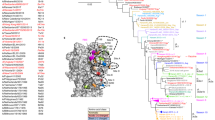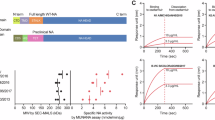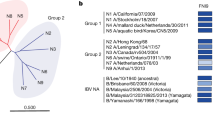Abstract
Influenza viruses remain a severe threat to human health, causing up to 650,000 deaths annually1,2. Seasonal influenza virus vaccines can prevent infection, but are rendered ineffective by antigenic drift. To provide improved protection from infection, novel influenza virus vaccines that target the conserved epitopes of influenza viruses, specifically those in the hemagglutinin stalk and neuraminidase, are currently being developed3. Antibodies against the hemagglutinin stalk confer protection in animal studies4,5,6. However, no data exist on natural infections in humans, and these antibodies do not show activity in the hemagglutination inhibition assay, the hemagglutination inhibition titer being the current correlate of protection against influenza virus infection7,8,9. While previous studies have investigated the protective effect of cellular immune responses and neuraminidase-inhibiting antibodies, additional serological correlates of protection from infection could aid the development of broadly protective or universal influenza virus vaccines10,11,12,13. To address this gap, we performed a household transmission study to identify alternative correlates of protection from infection and disease in naturally exposed individuals. Using this study, we determined 50% protective titers and levels for hemagglutination inhibition, full-length hemagglutinin, neuraminidase and hemagglutinin stalk-specific antibodies. Further, we found that hemagglutinin stalk antibodies independently correlated with protection from influenza virus infection.
This is a preview of subscription content, access via your institution
Access options
Access Nature and 54 other Nature Portfolio journals
Get Nature+, our best-value online-access subscription
27,99 € / 30 days
cancel any time
Subscribe to this journal
Receive 12 print issues and online access
209,00 € per year
only 17,42 € per issue
Buy this article
- Purchase on SpringerLink
- Instant access to full article PDF
Prices may be subject to local taxes which are calculated during checkout




Similar content being viewed by others
Data availability
The de-identified data sets used for the study are available on ImmPort (study no. SDY1436). Identifying data required to replicate the study analyses, such as exact age, are available by request as required by the institutional review board-approved protocol for the Nicaragua Household Influenza Transmission Study.
Code availability
Code to understand and assess the conclusions of this research is available via ImmPort (study no. SDY1436).
References
Nair, H. et al. Global burden of respiratory infections due to seasonal influenza in young children: a systematic review and meta-analysis. Lancet 378, 1917–1930 (2011).
Thompson, W. W. et al. Estimates of US influenza-associated deaths made using four different methods. Influenza Other Respir. Viruses 3, 37–49 (2009).
Nachbagauer, R. & Krammer, F. Universal influenza virus vaccines and therapeutic antibodies. Clin. Microbiol. Infect. 23, 222–228 (2017).
Jacobsen, H. et al. Influenza virus hemagglutinin stalk-specific antibodies in human serum are a surrogate marker for in vivo protection in a serum transfer mouse challenge model. MBio 8, e01463-17 (2017).
Nachbagauer, R. et al. A universal influenza virus vaccine candidate confers protection against pandemic H1N1 infection in preclinical ferret studies. NPJ Vaccines 2, 26 (2017).
Nachbagauer, R. & Palese, P. Development of next generation hemagglutinin-based broadly protective influenza virus vaccines. Curr. Opin. Immunol. 53, 51–57 (2018).
Hobson, D., Curry, R. L., Beare, A. S. & Ward-Gardner, A. The role of serum haemagglutination-inhibiting antibody in protection against challenge infection with influenza A2 and B viruses. J. Hyg. (Lond.) 70, 767–777 (1972).
Ohmit, S. E., Petrie, J. G., Cross, R. T., Johnson, E. & Monto, A. S. Influenza hemagglutination-inhibition antibody titer as a correlate of vaccine-induced protection. J. Infect. Dis. 204, 1879–1885 (2011).
Potter, C. W. & Oxford, J. S. Determinants of immunity to influenza infection in man. Br. Med. Bull. 35, 69–75 (1979).
Erbelding, E. J. et al. A universal influenza vaccine: the strategic plan for the national institute of allergy and infectious diseases. J. Infect. Dis. 218, 347–354 (2018).
McElhaney, J. E., Coler, R. N. & Baldwin, S. L. Immunologic correlates of protection and potential role for adjuvants to improve influenza vaccines in older adults. Expert Rev. Vaccines 12, 759–766 (2013).
Monto, A. S. et al. Antibody to influenza virus neuraminidase: an independent correlate of protection. J. Infect. Dis. 212, 1191–1199 (2015).
Sridhar, S. et al. Cellular immune correlates of protection against symptomatic pandemic influenza. Nat. Med. 19, 1305–1312 (2013).
Coudeville, L. et al. Relationship between haemagglutination-inhibiting antibody titres and clinical protection against influenza: development and application of a bayesian random-effects model. BMC Med. Res. Methodol. 10, 18 (2010).
Cauchemez, S. et al. Influenza infection rates, measurement errors and the interpretation of paired serology. PLoS Pathog. 8, e1003061 (2012).
Chen, Y.-Q. et al. Influenza infection in humans induces broadly cross-reactive and protective neuraminidase-reactive antibodies. Cell 173, 417–429.e10 (2018).
Rajendran, M. et al. Analysis of anti-influenza virus neuraminidase antibodies in children, adults, and the elderly by ELISA and enzyme inhibition: evidence for original antigenic sin. MBio 8, e02281-16 (2017).
Babu, T. M. et al. Population serologic immunity to human and avian H2N2 viruses in the United States and Hong Kong for pandemic risk assessment. J. Infect. Dis. 218, 1054–1060 (2018).
Zost, S. J. et al. Contemporary H3N2 influenza viruses have a glycosylation site that alters binding of antibodies elicited by egg-adapted vaccine strains. Proc. Natl Acad. Sci. USA 114, 12578–12583 (2017).
de Vries, R. D. et al. Influenza virus-specific antibody dependent cellular cytoxicity induced by vaccination or natural infection. Vaccine 35, 238–247 (2017).
DiLillo, D. J., Tan, G. S., Palese, P. & Ravetch, J. V. Broadly neutralizing hemagglutinin stalk-specific antibodies require FcγR interactions for protection against influenza virus in vivo. Nat. Med. 20, 143–151 (2014).
Park, J. K. et al. Evaluation of preexisting anti-hemagglutinin stalk antibody as a correlate of protection in a healthy volunteer challenge with influenza A/H1N1pdm virus. MBio 9, e02284-17 (2018).
Varble, A. et al. Influenza A virus transmission bottlenecks are defined by infection route and recipient host. Cell Host Microbe 16, 691–700 (2014).
Ng, S. et al. Estimation of the association between antibody titers and protection against confirmed influenza virus infection in children. J. Infect. Dis. 208, 1320–1324 (2013).
He, W. et al. Broadly neutralizing anti-influenza virus antibodies: enhancement of neutralizing potency in polyclonal mixtures and IgA backbones. J. Virol. 89, 3610–3618 (2015).
Couch, R. B. et al. Antibody correlates and predictors of immunity to naturally occurring influenza in humans and the importance of antibody to the neuraminidase. J. Infect. Dis. 207, 974–981 (2013).
Chen, Y. Q., Lan, L. Y., Huang, M., Henry, C. & Wilson, P. C. Hemagglutinin stalk-reactive antibodies interfere with influenza virus neuraminidase activity by steric hindrance. J. Virol. 93, e01526–18 (2018).
Kosik, I. et al. Neuraminidase inhibition contributes to influenza A virus neutralization by anti-hemagglutinin stem antibodies. J. Exp. Med. 216, 304–316 (2019).
Wohlbold, T. J. et al. Hemagglutinin stalk- and neuraminidase-specific monoclonal antibodies protect against lethal H10N8 influenza virus infection in mice. J. Virol. 90, 851–861 (2015).
Plotkin, S. A. Correlates of protection induced by vaccination. Clin. Vaccine Immunol. 17, 1055–1065 (2010).
Ekiert, D. C. et al. Cross-neutralization of influenza A viruses mediated by a single antibody loop. Nature 489, 526–532 (2012).
Lee, J. et al. Molecular-level analysis of the serum antibody repertoire in young adults before and after seasonal influenza vaccination. Nat. Med. 22, 1456–1464 (2016).
Paules, C. I., Marston, H. D., Eisinger, R. W., Baltimore, D. & Fauci, A. S. The pathway to a universal influenza vaccine. Immunity 47, 599–603 (2017).
Paules, C. I., Sullivan, S. G., Subbarao, K. & Fauci, A. S. Chasing seasonal influenza: the need for a universal influenza vaccine. N. Engl. J. Med. 378, 7–9 (2018).
Ng, S. et al. The timeline of influenza virus shedding in children and adults in a household transmission study of influenza in Managua, Nicaragua. Pediatr. Infect. Dis. J. 35, 583–586 (2016).
Ng, S. et al. Association between haemagglutination inhibiting antibodies and protection against clade 6B viruses in 2013 and 2015. Vaccine 35, 6202–6207 (2017).
Massingale, S. et al. Emergence of a novel swine-origin influenza A (H1N1) virus in humans. N. Engl. J. Med. 360, 2605–2615 (2009).
WHO Global Influenza Surveillance Network. Manual for the Laboratory Diagnosis and Virological Surveillance of Influenza (World Health Organization, 2011).
Margine, I., Palese, P. & Krammer, F. Expression of functional recombinant hemagglutinin and neuraminidase proteins from the novel H7N9 influenza virus using the baculovirus expression system. J. Vis. Exp. 6, e51112 (2013).
Wohlbold, T. J. et al. Vaccination with adjuvanted recombinant neuraminidase induces broad heterologous, but not heterosubtypic, cross-protection against influenza virus infection in mice. MBio 6, e02556 (2015).
Roush, S. W. et al. (eds) M anual for the Surveillance of Vaccine-preventable Diseases (Centers for Disease Control and Prevention, 2008).
Benjamini, Y., Krieger, A. M. & Yekutieli, D. Adaptive linear step-up procedures that control the false discovery rate. Biometrika 93, 491–507 (2006).
Acknowledgements
The authors thank past and present members of the study team based at the Health Center Sócrates Flores Vivas, the National Virology Laboratory at the Centro Nacional de Diagnóstico y Referencia, and the Sustainable Sciences Institute in Nicaragua for their dedication and high-quality work. We are grateful to the study participants and their families. Lastly, we thank F. Busto Carrillo for assistance in generating the figures. This work was supported by the National Institute for Allergy and Infectious Diseases (award no. R01 AI120997 to A.G. and contract nos. HHSN272201400008C to F.K. and HHSN272201400006C to A.G.). The funders had no role in study design, data collection and analysis, decision to publish, or preparation of the manuscript.
Author information
Authors and Affiliations
Contributions
A.G., F.K., S.N. and R.N. designed the study. A.G., G.K., L.G., A.B., S.O., R.L. and N.S. collected the data. M.P., D.S., A.R., R.L., A.F.G. and F.A. generated the laboratory data. S.N., R.N. and A.G. analyzed the data. S.N., RN, A.G. and F.K. interpreted the data. All authors critically reviewed the paper and approved of the final version of the paper for submission.
Corresponding authors
Ethics declarations
Competing interests
The Icahn School of Medicine at Mount Sinai has filed patent applications regarding influenza virus vaccines. The Krammer laboratory receives funding for universal influenza virus vaccine projects from the Department of Defense, PATH, the Bill and Melinda Gates Foundation and GlaxoSmithKline.
Additional information
Publisher’s note: Springer Nature remains neutral with regard to jurisdictional claims in published maps and institutional affiliations.
Extended data
Extended Data Fig. 1 Participant follow-up timeline.
Participant sample collection timeline with the number of samples collected from unique individuals (n = 300 individuals). Day ranges are represented as quintiles.
Extended Data Fig. 2 Preexisting antibodies and corresponding SARs in 2015 (n = 198 individuals).
a, PCR-confirmed infection. b, Symptomatic influenza. Note that the geometric mean baseline hemagglutination inhibition titer for this year was 1:10. The gray tags indicate a 50% protection level and the black tags indicate an 80% protection level. The gray bars show the proportion of household contacts having a certain level of preexisting antibody levels. The bars group individuals between the antibody levels covered by the bars on the x axis (for example, the left-most bar includes all individuals with antibody levels <10, followed by 10 but less than 40, etc.). The red lines fit the antibody level-specific SAR based on the observed rates, which are indicated as cyan points. The attack rate was calculated by dividing the number of infected contacts who had a specific baseline antibody level by the total number of contacts who had the same level of antibodies. The shaded area represents the 95% CIs.
Extended Data Fig. 3 Preexisting antibodies and corresponding SARs in 2013 (n = 102 individuals).
a, PCR-confirmed infection. b, Symptomatic influenza. Note that the geometric mean baseline hemagglutination inhibition titer for this year was 1:34. The gray tags indicate a 50% protection level and the black tags indicate an 80% protection level. The gray bars show the proportion of household contacts having a certain level of preexisting antibody levels. The bars group individuals between the antibody levels covered by the bars on the x axis (for example, the left-most bar includes all individuals with antibody levels <10, followed by 10 but less than 40, etc.). The red lines show the sigmoid function fitted to the observed antibody level-specific SARs, which are indicated as cyan points. The attack rate was calculated by dividing the number of infected contacts who had a specific baseline antibody level by the total number of contacts who had the same level of antibodies. The shaded area represents the 95% CIs for the predicted antibody level-specific SAR.
Extended Data Fig. 4 Influenza outcome-specific distribution of preexisting antibodies.
a, 2015 influenza A (H1N1) pandemic epidemic. b, 2013 influenza A (H1N1) pandemic epidemic. Antibody levels for each individual, and the median and interquartile range, are shown. The y axis indicates the antibody levels. Individuals were separated by PCR-positivity status (blue dots) and by symptomatic influenza (green dots). Individual antibody titer data points were compared between disease outcome groups using a two-tailed Wilcoxon rank-sum test. Analyses were performed combined (all ages; 2013: n = 102 individuals; 2015: n = 198 individuals) as well as separately for children (0–14 years old; 2013: n = 38 individuals; 2015: n = 64 individuals) and adults (15–85 years old; 2013: n = 63 individuals; 2015: n = 135 individuals). See Supplementary Tables 5 and 6 for the FDR analyses. Age groups and outcomes were prespecified before the analyses.
Extended Data Fig. 5 Protective effects associated with a fourfold increase in antibody level among children.
Results are shown for three different sets of assays. a, PCR-confirmed infection. b, Symptomatic influenza (n = 101 individuals). Assay set 1 combines hemagglutination inhibition, hemagglutinin stalk and neuraminidase ELISAs. Assay set 2 combines full-length hemagglutinin and neuraminidase ELISAs. Assay set 3 combines hemagglutination inhibition and neuraminidase ELISAs. Adjusted ORs for the single-assay model are shown as green squares and the multi-assay model as orange circles. The black lines denote the 95% CIs.
Extended Data Fig. 6 Protective effects associated with a fourfold increase in antibody level among adults.
Results are shown for three different sets of assays. a, PCR-confirmed infection. b, Symptomatic influenza (n = 199 individuals). Assay set 1 combines hemagglutination inhibition, hemagglutinin stalk and neuraminidase ELISAs. Assay set 2 combines full-length hemagglutinin and neuraminidase ELISAs. Assay set 3 combines hemagglutination inhibition and neuraminidase ELISAs. Adjusted ORs for the single-assay model are shown as green squares and the multi-assay model as orange circles. The black lines denote the 95% CIs.
Extended Data Fig. 7 PPVs and NPVs of the best serology testing strategy identified by decision tree analyses.
True positive cases were individuals who had PCR-confirmed influenza virus infection. True negative cases were individuals who had neither a positive PCR nor a fourfold rise in antibody serology tests. The model also suggested optimal cutoff points to use when defining seroconversion.
Extended Data Fig. 8 Sensitivity and specificity of hemagglutination inhibition and ELISA in detecting PCR-confirmed infections.
Curves are plotted as solid lines for sensitivity (Sn) in blue and specificity (Sp) in green. The shaded areas indicate the 95% CIs. The x axes show the fold induction for the respective assay. Analyses were performed combined (all ages, n = 300) as well as separately for children (0–14 years old, n = 101) and adults (15–85 years old, n = 199).
Extended Data Fig. 9 Antibody titer correlations.
a–c, Correlation analyses for antibody titers were performed combined (all ages, n = 300 individuals) (a) as well as separately for children (0–14 years old, n = 101 individuals) (b) and adults (15–85 years old, n = 199 individuals) (c). Pearson’s r is plotted in each figure.
Supplementary information
Supplementary Information
Supplementary Tables 1–6
Rights and permissions
About this article
Cite this article
Ng, S., Nachbagauer, R., Balmaseda, A. et al. Novel correlates of protection against pandemic H1N1 influenza A virus infection. Nat Med 25, 962–967 (2019). https://doi.org/10.1038/s41591-019-0463-x
Received:
Accepted:
Published:
Issue Date:
DOI: https://doi.org/10.1038/s41591-019-0463-x
This article is cited by
-
Immune history shapes human antibody responses to H5N1 influenza viruses
Nature Medicine (2025)
-
Influenza neuraminidase active site proximity assay for rapid profiling of inhibitory antibodies and antigenic drift
npj Vaccines (2025)
-
Breadth of influenza A antibody cross-reactivity varies by virus isolation interval and subtype
Nature Microbiology (2025)
-
Influenza antibody breadth and effector functions are immune correlates from acquisition of pandemic infection of children
Nature Communications (2024)
-
Vaccine design via antigen reorientation
Nature Chemical Biology (2024)



